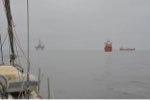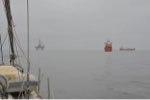

The steady thrum of Totem’s Yanmar beat the departure march from Walvis Bay. Heading out under foggy skies, there’s precious little wind to tackle 1200 nautical miles and change to St Helena. That’s fine: much as we’d rather sail, this gets the battery bank fully charged, and the watermaker will run for hours; things we need to do anyway.
When the breeze does fill in, it starts well forward of the beam. Totem charges upwind in 18-20 apparent, but reasonable seas keep conditions fine on board. Pointing well above the rhumb line for a more comfortable sail, by nightfall the breeze comes back and Totem settles into a comfortable beam reach in gentle swells. I’m grateful for an easy first day, where we eventually put away about 150 miles.
Unlike our trip up the coast, there is no stream of visits from abundant wildlife; only a few seals, albatross and handful of cape gannets to break the monotony. Shipping traffic runs invisible lanes parallel to the coast around 100 miles offshore; beyond that, there’s nothing but the rise of white-tipped wind waves on swells. That’s fine. Sharing notes with a friend who just took off to go cruising with her husband, Cidnie reminds me “boring is good!” But that night, the bioluminescence puts boring in jeopardy in the best possible way with a brilliant show, lighting up our wake.
Day 2
The second day cracks blue in the gray skies we’ve recently become accustomed to seeing. All along the Namibian coast, a marine layer forms when cold air from the chilly Benguela current meets the heat of the desert. But in my early morning watch, first glimpses of stars peek between clouds before the sky turns pink.
The water temp gradually rises, another sign we’re leaving the Antarctic-chilled current behind. It matches pace with the air temperature: we finally crack 70 degrees, then 74 by late afternoon. But the gray clouds persist, and despite the increase we’re still bundled in fleece and foulies for the evening chill. It’s a gorgeous run of more reaching, with the wind mostly on our port quarter, and we average an easy 7 knots.
We’re trying a new night watch routine: I’m on until 9, then Ty and Jamie each take 3-ish hour watches, and I’m up with the starlight to pick up again…except so far, that get-up-at-3 part is eluding me, and Jamie’s too kind to really push me to get up—giving me extra Zzzzs and catching up on his own rest with daytime naps. But overall, it’s an easy schedule with so many hands to share rotation. The kids help, too: besides owning all dishwashing and meal cleanup, they stand ad-hoc watch to fill in when we’re napping or otherwise occupied.
Day 3
We crossed the Tropic of Capricorn between Luderitz and Walvis Bay more than a week ago, but it’s not until the third day at sea that it feels like we’re in the tropics again. Air and water temps are now over 76 at midday. Foulies are finally shed for night watch. The sea takes on that gorgeous clear cerulean that only the tropical ocean seems to deliver, under a wide-open blue sky.
Since getting away from the coast, we’ve hardly seen any ships, so it’s a strange feeling when a fishing vessel shows up on a collision course from 50 miles away. We track it on AIS, and end up passing the 150’ Japanese trawler port to port with about a mile gap between vessels, and the odd sensation of having found a needle in the haystack.
Day 4
Today the kids work on a continuing project with an 8th grade math class in Massachusetts. We were approached by a teacher who thought measurable comparisons between lifestyles would be an interesting, tangible foil for teaching math. Sounds great! So far, the kids have compared something very immediate for teenagers: their clothes. Breaking down the number of pieces by different types (socks, shirts, jackets, etc), and also comparing the available storage space used for clothing storage. It’s prompted some interesting questions and observations on both sides of the Atlantic, as the kids share metrics and Q&A.
Siobhan and I knock out daily cribbage games in the cockpit in the shade of a tattered batik sarong. We’re four days in, but not once have I heard a version of “how much longer?” or “are we there yet?” Reaching is fast and comfortable on Totem, and the days cruise by. Jamie dials up PredictWind’s new iPad app for Offshore to check our forecast, and it is happily devoid of surprises. A few ticks now and then adjust course keep the sails filled and the boat humming along, on a great pace to get to St Helena in about eight days.
This post is syndicated on Sailfeed. It’s posted through a satellite device from approximately the middle of nowhere, South Atlantic Ocean…more photos when we have better bandwidth.

